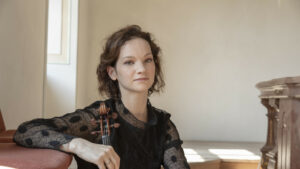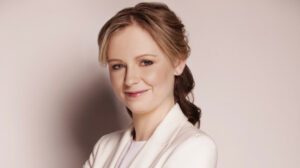New Zealand Opera presents:
VERDI – Macbeth
Cast: Macbeth – Phillip Rhodes
Lady Macbeth – Amanda Echalaz
Banquo – Wade Kermot
Macduff – Jarred Holt
Malcolm – Emmanuel Fonoti-Fuimaono
Lady-in-Waiting – Morag Atchison
With Orchestra Wellington
Conductor: Brad Cohen
Director: Netia Jones /Lightmap
Assistant Director: Jacqueline Coats
Lighting Designer: Matthew Marshall
Chorus Director: Michael Vinten
St James Theatre, Wellington
7th.October 2022 (also 9th October 2:30pm,)
The dark stage is raked up to the left. Not steeply, but enough to throw all the lines and angles off plumb. It is bare and black, with a gauze at the front creating spatial ambiguities.
Long before the last audience member has taken their seat, we are in the dark, crooked world of Macbeth, in which fair is foul and foul is worse than you imagined.
This is a reimagined Macbeth. There is nothing historic and Scottish about it. These are not – despite what the programme says – the brutish leaders of brawling clans, dashing from one pele tower siege to the next. Nor has it been updated to the unstable present. No one carries blue and yellow flags as Birnam Wood retakes Dunsinane.
Instead, the drama is set on the stage of the imagination.
What happens when someone conceives of a wicked act to advance themselves, and then carries it out? Shakespeare imagines that they become unhinged. Lacking a moral compass, there is no guide for where to go next. Verdi agrees, though he points to the political and human consequences (the refugees in Act 4). And the director of this production thinks that the desire to kill may be accompanied by other beastly proclivities. In this Macbeth, Lady Macbeth is ravenous for power and sex. She is powerful and controlling. He is weak and often uncertain.
The stage in the opening scene reminded me of a black-and-white television set. Lots of black, with ambiguous straight lines. Then a woman enters, dressed in black and white, reading a piece of paper – followed by another and another. Finally there are about 20 of them, lined up along the wall on the left-hand side of the stage. They are the witches; in Verdi’s version not three women but ‘three groups of witches’. This is an unfortunate decision on the part of Verdi or his librettist. If they had asked me, I would have argued against it. It sacrifices the particular drama of the three weird sisters, each individualized, for a mass effect – and in this scene the witches look like a group of schoolgirls diligently studying their homework.
Indeed, in his essay on Macbeth the play in the programme, literary scholar Tom Bishop says that the witches ‘were a strong selling point’ in Shakespeare’s productions and the many subsequent revivals. (Samuel Pepys saw it nine times, calling it ‘one of the best plays for a stage … that I ever saw’.)
When Macbeth (Philip Rhodes) enters, he is wearing a stylish dark overcoat that he is careful to show us has a scarlet satin lining. The colour symbolism of the production design is straightforward: lots of black and dark grey, some white (but it doesn’t indicate purity), splashes of scarlet standing for death and lust, sometimes relieved by an intense turquoise. And that’s it.
The lighting design is simple. The stage is mostly shadowed with one or two points of light. Sometimes there is a kind of inhospitable grey light – the blank grey of a black and white television screen with the power off. But creative energy has been poured into the projections. Branches indicate a wood; an enormous closeup of Macbeth’s face with touches of red and turquoise indicates his power as king; giant hands covered in blood or washing themselves indicate guilt. Almost everything is in monochrome, maintaining the moral murk of the action.
With the visual language so simplified, the focus is thrown on the singers. Again, Verdi’s choice of voices is interesting. Macbeth is a baritone, as are Banquo (sung by Wade Kernot), the singing Assassin (Stuart Coats), the Doctor (Matthew Landreth), and the male Apparition (William McElwee). There are no tenors on stage until Act 4, when Macduff (Jared Holt) and Malcolm (Emmanuel Fonoti-Fuimaono) arrive to defeat Macbeth’s army at Dunsinane and take back the throne of Scotland. It is a relief.
The baritone rumble throws the soprano of Lady Macbeth (Amanda Echalaz) into the spotlight. She is the most animated character, with a full emotional palette from ambitious to exultant, lascivious, frustrated (by Macbeth’s weakness), and finally remorseful and unhinged. Accordingly she is given terrific clothes as well as great arias. My favourite outfit was the black and red dress in the Act 2 banquet scene. She vamps around the stage in what seems to be a scarlet skirt with black leggings underneath, throwing herself at her husband with all the propriety of a pole dancer, eventually throwing off the scarlet skirt to show her true self in trousers, taking action.
This being NZ Opera, the production is musically stunning. An essential Orchestra Wellington played well under Brad Cohen, with some great brass playing at portentous moments, and some lovely clarinet and bassoon solos. The chorus sang well, and the soloists were fantastic. I have always been a fan of Philip Rhodes, and he and Wade Kernot (Banquo) carried much of the opera on their shoulders. South African soprano Amanda Echalaz was excellent. She has a lovely voice with all the brilliance required, and acted well. Readers of my review of Opera Wellington’s recent La Traviata will recall my excited rave about newcomer Emmanuel Fonoti-Fuimaono. He did not disappoint here as Malcolm, mastering the right amount of youthful nobility and strength of purpose, and singing beautifully alongside the experienced Jared Holt (an audience favourite, to judge by the applause).
My favourite moments concerned the apparitions. After the interval, the raked stage is revealed to have a huge fissure in it. I thought at first it was symbolic of a rift in something – the body politic? – and was painted on. But in Act 3, summoned by the witches, the apparitions rise up from it, singing their fateful prophecies, and eventually a series of nine little child kings emerge, all dressed in red, with small iron crowns on their heads, like Macbeth’s own. They are Malcolm’s children, who will inherit the throne despite Macbeth having murdered their ancestor Duncan.
This is a theatrical device that Shakespeare would have approved of, having used the trapdoor in the stage of the Globe Theatre to have the witches suddenly appear and disappear. In fact, I think he would have enjoyed the whole production. Verdi’s libretto is more economic than the text of the play – which is itself concise. But this production carried the same diabolical power as the original, and the same ghastly depiction of evil and its effect on the human mind.

